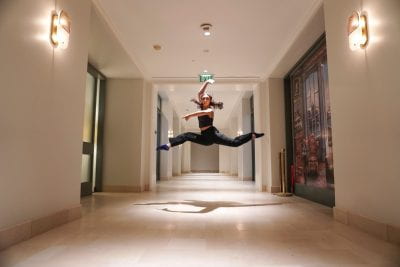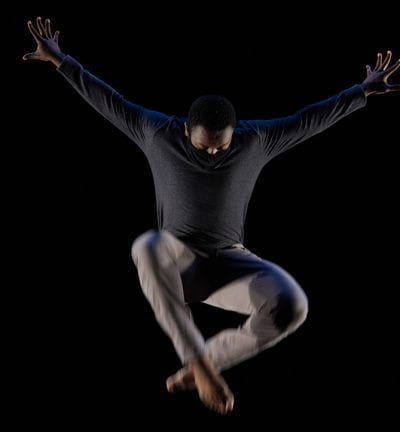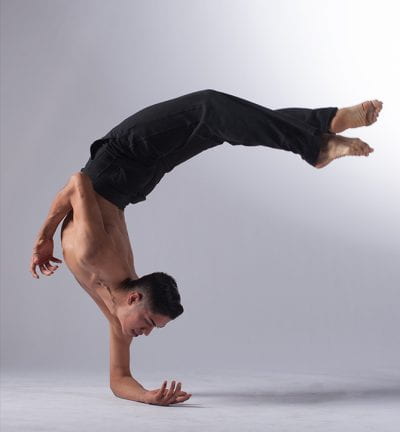Three Pathways to Dance
Stacy Pauline, ’22 BFA Dance, Casey Kitazumi, ’20 BFA Dance, Angela Bass, ’22 BFA Dance, and Joan Pasion, ’20 BFA Dance, performed “now and then…”, a piece by Davarria Ford, ’22 BFA Dance, as part of the College of Humanities and the Arts’ Pandemic Pandemonium competition in winter 2020.
Imagine dedicating years to studying dance, auditioning for a competitive dance program and enrolling in class — only to learn that, thanks to a global pandemic, you must dance without touch, wearing two masks, on a springy outdoor floor inside a parking garage. Or perhaps you’re a working dancer suddenly limited to performing on camera inside your home, if at all.
Nearly three years into the pandemic, three dance alumni share news of their latest achievements.
“These three alumni artists are unique in their artistic visions and paths,” said Diane Frank, dance lecturer at San José State University. “What they have in common is whole-heartedness and a deep conviction that dance not only embodies and communicates the current cultural moment but also that dance creates cultural change.
“Beyond technique and craft, SJSU training includes a vision, a larger intention — and that is what fuels their persistence and creative drive. The intention to engage daily, their sense of personal agency, is cultivated at SJSU — and it gets them through challenging times and circumstances, like the past three years of pandemic and social upheaval.”
Embracing and choreographing the unexpected

Choreographer and dancer Angela Bass, ’22 BFA Dance, interned with the Doug Varone and Dancers intensive in summer 2022. Photo courtesy of Angela Bass.
In her short film, “Guided,” Angela Bass’ solo dance alternates between an urban setting and a wintry orchard as she interacts with the falling leaves and the hay-strewn ground. Bass, ’22 BFA Dance, choreographed, performed and edited the film as part of an SJSU digital production class offered in the height of the pandemic.
“As artists, we always incorporate what is happening in the world with our work,” she said. “When I’m creating a dance, I’m making something out of my life experience.”
Bass transferred to SJSU from Modesto Junior College in 2019 after completing her associate degree in dance — mere months before COVID-19 forced SJSU’s dance department to get creative with their practice spaces. She learned to dance in a mask, separated six feet from her peers as they rehearsed in SJSU’s 10th Street garage, and choreographed a group piece inspired by the tumult of the world around them.
“I like building off each other’s bodies — starting with movement and breaking it apart,” she said. “The piece was about the pandemic and how we can find hope again.”
In fall 2021, when award-winning dancer and choreographer Doug Varone accepted a residency at SJSU, Bass was thrilled. Varone and his company visited dance classes before performing at the Hammer Theatre in October. The choreographer offered a unique opportunity to Spartan dancers: the chance to audition for workshops at his New York dance studio.
Bass was all too ready to leap into the ring. By summer 2022, just a few weeks after graduating, she and Davarria Ford, ’22 BFA Dance, were among 12 SJSU dancers in residence at Varone’s company at Purchase College at the State University of New York. As a company intern, she conducted behind-the-scenes interviews and gained a unique perspective on the skills required to run a professional company.
Since graduating, Bass has moved to Arizona, where she has already connected with her local dance community.
Her advice to fellow dancers? “Keep your head up. There are going to be a lot of things in your way of your dream. But if you want to shoot for it, I’d say go for it. Anything can happen.”
From YouTube to New York City

Davarria Ford, ’22 BFA Dance, performed in two competitive dance workshops in New York following graduation. Photo courtesy of Davarria Ford.
Davarria Ford said that his first dance teacher was YouTube. Mesmerized by clips from films like “Step Up” and “Stomp the Yard,” Ford taught himself to step in middle school and made his debut at the sixth-grade talent show.
“Most dancers start off really young by going to classes at a studio for hours a day,” the Hayward native said. “They’re constantly training. Any dance I did was connected to school, whether it was through P.E. or free clubs and activities — and YouTube.”
When Ford auditioned for San José State’s Dance department in 2017, he couldn’t wait to expand his repertoire. He joined the University Dance Theater ensemble and rehearsed on his own or attended class for several hours a day. When the pandemic hit, he had to learn how to dance in the 10th Street Garage, sometimes attending classes over Zoom from home.
His adaptability and willingness to work hard came in handy when he applied and was admitted into two competitive dance intensives — the Doug Varone dance intensive at SUNY Purchase and the Merce Cunningham Fellowship Workshop in New York City. Both experiences offered him the chance to rehearse and perform with professional dancers, the latter focused on recreating “Doubletoss,” one of Cunningham’s original compositions.
“The whole experience of dancing in New York was really cool,” he said. “I’d never been there and within a few weeks of graduating from SJSU, I went twice. I sublet an apartment in Brooklyn and traveled into Manhattan every day to dance with professional dancers. It felt like a sneak peek of what my dance life could be.”
Out and beyond the shadows

Choreographer and dancer Gabriel Mata, ’15 BFA Dance, uses dance to create dialogue about identity. Photo by Keay Edwards.
Though Gabriel Mata, ’15 BFA Dance, graduated from SJSU prior to the pandemic, the experience crystallized his dedication to the craft. The stay-at-home order, which occurred while he was pursuing an MFA at the University of Maryland, College Park, forced him to adapt his performances and teaching to an online format, inspiring him to create a trio of dance films.
An accomplished choreographer whose work has been performed in venues across Minnesota, California, New York, North Carolina, Maryland, Pennsylvania and New Jersey — as well as at the John F. Kennedy Center for the Performing Arts in Washington D.C. — Mata’s work explores his intersecting identities as a self-identified queer Latinx immigrant and recent permanent resident of the U.S.
But immigration status, like sexuality or religion, is not binary, Mata added. One of the first evening-length pieces he choreographed, “Out of the Shadows,” explored the vulnerability it takes to reveal one’s truth.
“I connected with the dance and the performance because I felt so hyper-aware of every part of my body,” he recalled. “Then I made the connection to my undocumented upbringing. It’s intentionally called ‘Out of the Shadows’ as a part of exposing my body, but also my undocumented identity.”
An eight-year veteran of sjDANCEco, Mata has also danced for haus of bambi, Post:Ballet, Zenon Dance Company, Mark Foehringer Dance Projects, and Pearson Widrig Dance Company. He supports fellow artists as part of his own professional growth, taking advantage of opportunities offered by places like the DC Commission on the Arts and Humanities and the Kennedy Center REACH Campus Office Hours Residency.
His vision? To create art and support undocumented artists.
“As a choreographer, I want to understand my relationships to dancers — not just how they move but also how they contribute to the world,” he added. “Because I have prioritized my own identity, I want to hold space for others to speak and move.”




